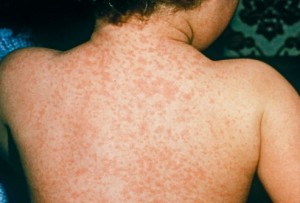Measles outbreaks have been on the rise, after the virus was nearly eradicated in the United States, in 2000. Mostly these infections are on the rise because of people choosing not to give vaccinations to their children, for whatever reason. Measles is a very serious virus, and it is most dangerous to children under the age of 5, and as more and more children have been vaccinated worldwide, the rate of death from measles dropped off, but it is now becoming more of a threat. Regardless of the reason/s that you don’t think that you should get vaccinations, you cannot deny that denying vaccinations not only puts your child at risk, but others as well, and measles outbreaks are becoming more and more frequent.
What are Measles?
The measles are a virus, also known as rubeola, that usually has four stages, over a course of two to three weeks, and with varying symptoms from first exposure (which occur over 7 to 14 days) such as: fever, cough, runny nose, sore throat, pink eye (inflamed eyes), tiny white spots with bluish centers in the corners of the inside of the cheeks (AKA Koplik spots), and a large blotchy skin rash.
The three stages:
1. Incubation Period: from 7 to 14 days after first exposure, you may have no symptoms at all, as you have been exposed and the virus is just starting to take shape.
2. Early Symptomatic Phase: You start to develop some generalized symptoms like fever, cough, runny nose. You might think that you have a regular cold at this point, unless you happen to notice Koplik spots.
3. Acute infection: after 3 days of the generalized symptoms, a red bumpy and blotchy rash will start on the face and around the ears to the hairline, which will spread down to the neck, chest abdomen, then to arms and legs. At the same time as the rash is spreading, an intense fever to 104F-105F will also occur. This phase can last for about a week.
4. Infectious State: you may not feel sick or that you have the measles 4 days before you see a rash, but that is when you are able to spread the virus to others, and you remain infectious to others for up to 4 to 7 days AFTER the rash has completely gone away. It is easily spread from person to person through coughing, touching mucus in any form (sneeze droplets, etc.), and from inhaling the exhalation from an infected person. The virus can stay alive on a surface for several hours and can infect a person through rubbing eyes, nose and/or mouth.
Why is it so serious?
There are some complications that can occur, which can lead to long-term health issues or lead to death: bacterial ear infections, swelling of the brain (encephalitis), bronchitis, pneumonia, and can lead to serious complications in pregnant women. Some of these can be very hard to treat due to the concurrent infection, but encephalitis can be very serious leading to death if the brain swelling is uncontrolled, and the complications with pregnancy can be very severe for the fetus.
The up-side:
If you have not been vaccinated, and find out that you have been exposed, within 3 days of exposure, you can receive the measles vaccine, and if you do get the symptoms of the virus, they are very mild and there is less of a risk of the other complications. Usually when these outbreaks occur, the sources are quickly located and the news and other sources are very good about getting the word out about possible exposures, so if you think you have been exposed, get vaccinated.
You don’t have to get vaccinated, but if you do end up getting infected, the risk of transferring the virus to others is very high, and the exposure to small children and those who may be immune suppressed due to cancer, medical treatments, or older age, can be deadly. As a favor to yourself, and to those around you, no matter what your beliefs are, think about getting the vaccine, and vaccinating your children, it could be the difference between life or death.
Yours in Good Health
B

